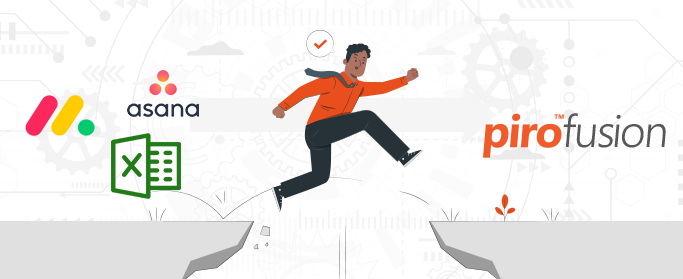The Beginnings
There are only a few jewelry companies that have received investment and were able to start off as major players immediately. Among the names we found are Mejuri, Aurate, Gemist, Kimaï, and Vrai & Oro.
Most companies, however, start small, often relying on loans, and then enter a growth phase.
Given that costs during this phase are primarily driven by product development, sales channel expansion, and marketing, one question typically arises at the end of the line: what management tools can I use to manage this company?
The holy grail for jewelry start-ups: Excel spreadhseets
Although we lack specific statistics on this, there are only a few companies that haven’t gone through the Excel and spreadsheet phase. It’s such a straightforward solution that most startups turn to it. One spreadsheet for inventory, another for orders, a third for tracking purchases, and yet another for price calculations. Sound familiar?
Tracking things across various spreadsheets is perfectly fine - until complexity starts to grow in the business or until managing the spreadsheets consumes too much valuable time and becomes unsustainable.
Excel is a completely predictable system. It reliably calculates what it is set to. However, it will not alert you to user errors. It won’t automatically order a diamond if a special item is needed for a new order. Excel does not "think," it does not automate; it simply executes.
Therefore, the business will reach a growth level where the limitations of Excel will no longer support further development.
Digital Transformation: The Big Leap
What does digital transformation mean? Isn’t Excel already digital?

Digital transformation goes beyond Excel-like data management. It encompasses much more. Digital transformation involves modernizing business processes with the primary goals of improving customer experience, increasing efficiency, and providing a competitive edge.
In simple terms, Excel represents basic data management, while digital transformation involves implementing an ERP system that significantly automates data management and processes.
Let’s review these goals and discuss how a jewelry ERP like PIRO can help achieve them:
- Modernizing business processes: The system consolidates previously loosely managed processes. No more “If I need to know where an order is, I ask John.” The essence of the system is to separate information and knowledge from individuals. It’s no longer the case that only Mark can create a price quote for a customer; with the system’s help, anyone can do it without making mistakes.
- Improving customer experience: This can vary from company to company, as customer experiences have many components. Customer experience can improve by assembling quotes more quickly or by providing automated notifications about order status. For B2B clients, we can offer a platform where they log in and see all relevant data from the ERP in real-time. Customer experience can also improve by eliminating human errors, delivering orders on time, and not wasting valuable time making excuses.
- Increased efficiency: Moving from Excel to an advanced jewelry system will show a noticeable increase in efficiency. Automatic reordering of components at the right time? Generating invoices with two clicks? Assembling price quotes in a quarter of the time compared to before? Inventory movements happen automatically without the need for manual adjustments, as with Excel. The increase in efficiency lies in automating repetitive tasks. With the same number of employees, more orders can be processed. The ERP system ensures that almost every activity in the company is connected.
- Competitive advantage: A well-functioning system in itself represents a competitive advantage. It depends on the type of competition and direct rivals. Price competition? Be more efficient to reduce costs. Better customer experience? Serve customers faster and more transparently to ensure they return. More attractive products? PIRO frees up your management time so you can focus solely on product development.
It can also be said that this is a one-way street. I cannot think of examples where someone returned to Excel-based tracking after implementing the system. We have heard of cases where, alongside the ERP, certain things were tracked in Excel again, but this generally has two causes:
- An inappropriate jewelry system was chosen and could not adequately automate certain processes.
- Too many shortcuts or workarounds during system implementation led to long-term negative effects.
Getting ready for digital transformation
 There’s no such thing as starting too early with ERP implementation. We have encountered many startups with experienced founders who wanted to begin with a comprehensive system from the outset. In such cases, the ERP becomes an integral part of the company’s culture and operations.
There’s no such thing as starting too early with ERP implementation. We have encountered many startups with experienced founders who wanted to begin with a comprehensive system from the outset. In such cases, the ERP becomes an integral part of the company’s culture and operations.
If you are also considering a transition, it’s wise to prepare and ready both the company and the employees. A system is only as good as its users. Unconvinced employees may "forget" to enter data into the system, effectively boycotting its use and necessity.
Parallel to preparing employees, you can start mapping the company’s processes. What is the biggest pain point? What causes the most frustration? What must be improved?
All this is important because if you do not correctly identify your needs, you might end up choosing the wrong system. Think holistically and do not focus on just one segment.
Many retail companies that manufacture custom jewelry in-house define themselves as retail companies and seek POS or inventory systems, neglecting the fact that manufacturing management is left hanging. They then look for another system to manage it. Did you know that PIRO can handle both in one system?
There is a lot PIRO can offer in each segment of a jewelry business operation. Contact our representatives if you need a comprehensive consultation: here.





